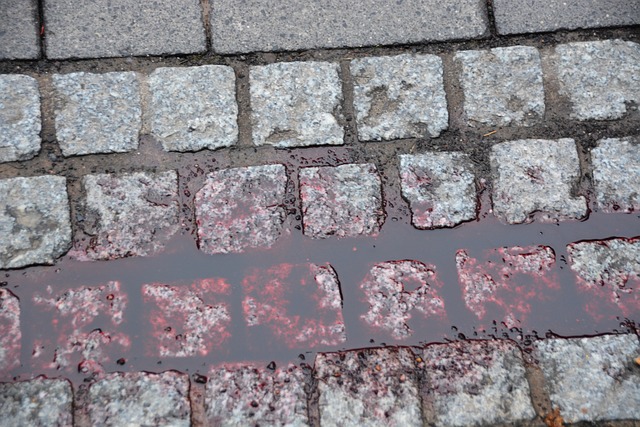Understanding grout stain causes is crucial for effective removal. Preventative measures include regular cleaning with mild solutions, sealing grout lines with high-quality sealants, and using natural ingredients like baking soda and vinegar. Commercial grout cleaners offer powerful options for stubborn stains. Regular cleaning and reapplying sealant every few years are key to maintaining grout lines. DIY methods tackle common stains, while professionals handle severe cases.
Tired of dealing with unsightly grout stains? This comprehensive guide is your go-to resource for achieving sparkling, stain-free grout lines. We demystify the causes of grout stains, equip you with essential cleaning tools, and explore a range of effective solutions. From natural remedies to DIY recipes and commercial products, we’ve got you covered. Learn proven prevention techniques, follow step-by-step removal guides, and discover maintenance tips to keep your grout lines looking fresh. Say goodbye to stained grout once and for all!
Understanding Grout Stain Causes

Understanding what causes grout stains is crucial before attempting any removal methods. Grout lines, often made of cement or sand mixtures, are porous and can absorb liquid substances like coffee, tea, wine, ink, or even water-based stains from cleaning products. Over time, these stains can become ingrained in the grout, making them difficult to eliminate. Additionally, factors such as poor ventilation, excessive moisture, and inadequate cleaning routines contribute to stained grout lines.
Regular cleaning and sealing can significantly help prevent grout stains. Using appropriate cleaning solutions and avoiding harsh chemicals that may damage the grout is essential. Sealing the grout lines with a high-quality sealant can also provide an extra protective layer, making it easier to remove surface stains in the future.
Essential Tools for Grout Cleaning

Removing stains from grout lines doesn’t have to be a daunting task. First, gather some essential tools designed for this purpose, such as a stiff-bristled brush, a vacuum cleaner with an attachment, and a mixture of warm water and mild detergent or a grout cleaning solution. The sturdy brush will help you scrub away dirt and dislodge stubborn stains, while the vacuum ensures that loose debris is removed efficiently. Combining warm water with a gentle cleanser creates a powerful yet safe cleaning agent, effectively tackling even deep-seated grime.
Additionally, consider investing in a grout sealer to protect your freshly cleaned lines from future staining. This protective layer can significantly extend the time between thorough cleanings, saving you time and effort in the long run. With the right tools and some basic knowledge, maintaining the pristine appearance of your grout is more achievable than ever before.
Natural Solutions for Removing Stains

Removing stains from grout lines doesn’t have to involve harsh chemicals. There are numerous natural solutions that can effectively tackle common grout stains, making your tiles look as good as new. One popular choice is baking soda, a gentle abrasive that can dislodge even the toughest grime. Mix it with a bit of water to form a paste and apply it directly onto the stained area. Let it sit for a few minutes, then scrub gently with an old toothbrush or sponge. This simple method is perfect for light-colored grouts as it won’t stain your tiles.
Another eco-friendly approach is using vinegar, which has natural cleaning properties. Create a solution of equal parts white vinegar and warm water, and apply it to the stained grout lines. Let the mixture soak for around 15 minutes, then wipe away with a damp cloth. For stubborn stains, you can add a squeeze of lemon juice to the vinegar solution for an extra boost of cleaning power. These natural solutions are not only cost-effective but also safe for use in homes with children and pets.
DIY Grout Cleaner Recipes

Removing stains from grout lines doesn’t have to be a costly endeavor. Many effective DIY grout cleaner recipes can be made at home with common household ingredients. One popular option is to mix one cup of white vinegar, one tablespoon of baking soda, and a few drops of dish soap in a spray bottle. This concoction is not only affordable but also eco-friendly. The acidity in the vinegar helps to break down the stain, while the baking soda acts as an abrasive to scrub away grime.
Another simple and cheap solution involves using lemon juice. Cut a fresh lemon in half and rub it directly on the stained grout lines. Let the juice sit for about 15 minutes before scrubbing with a soft-bristled brush. The citric acid in lemons is a natural stain remover. For more stubborn stains, create a paste from baking soda and water, apply it to the affected areas, let it sit for a few hours, then scrub away the paste and any remaining residue. These DIY methods not only save money but also allow you to maintain the appearance of your grout lines without resorting to harsh chemicals.
Effective Commercial Products for Grout Stain Removal

When it comes to tackling grout stain removal, there are several effective commercial products available that can make this task easier. These solutions are designed to penetrate and lift stains from grout lines, leaving them clean and refreshed. One popular option is oxygen-based bleach, which is gentle yet powerful enough to eliminate common grout discoloration caused by mold, mildew, and various chemicals. It’s an eco-friendly choice for those seeking a natural approach to stain removal.
Another reliable option are grout cleaners in gel or powder form, often containing ingredients like citric acid or sodium bicarbonate. These products are versatile and can be used on various surface types. They effectively dissolve grease, grime, and even some stubborn stains, making them ideal for heavy-duty cleaning. Many commercial grout stain removers come with easy-to-follow instructions, ensuring that homeowners can achieve professional-looking results without specialized equipment.
Preventing Future Grout Stains

To prevent future grout stains, regular cleaning is key. Start by sweeping or vacuuming your tiled surfaces often to remove loose dirt and debris that could lead to staining. Use a soft-bristled brush to gently scrub away any visible stains in the grout lines promptly. This proactive approach will help maintain the cleanliness and aesthetic appeal of your tiles and grout.
Additionally, sealing the grout can provide an extra layer of protection against stains. Waterproof sealants designed for grout can be applied to create a barrier between the grout and potential staining agents like mold, mildew, or even coffee spills. Following manufacturer instructions, reapply the sealant every few years to ensure maximum effectiveness in removing stains from grout lines.
Step-by-Step Guide: Removing Common Grout Stains

Removing common grout stains is a straightforward process that can significantly rejuvenate your tiled surfaces. Here’s a step-by-step guide to help you tackle these unsightly marks. Start by vacuuming or sweeping the floor to remove any loose debris. Next, apply a grout cleaner or a mixture of water and baking soda directly onto the stained area. Let it sit for about 15 minutes to allow the cleaning solution to penetrate the stain. Using an old toothbrush or a grout cleaning tool, gently scrub the stained lines in a back-and-forth motion. Pay special attention to the edges and corners where stains tend to build up. After scrubbing, rinse the area thoroughly with warm water to remove any residual cleaner. For tougher stains, repeat the process until the marks fade away. Remember, regular maintenance is key; promptly addressing new stains will make future cleaning easier.
Tips for Maintaining a Fresh-Looking Grout Line

Keeping your grout lines looking fresh is an easy and affordable way to enhance the overall appearance of your tiled surfaces. Regular cleaning is key; use a soft-bristled brush and mild detergent to remove any dirt or debris that may have accumulated. For stubborn stains, consider using a mixture of baking soda and vinegar—a natural and effective cleaner. Apply this paste to the stained area, let it sit for a few minutes, then scrub gently with your brush. Rinse thoroughly to reveal clean grout lines.
Additional maintenance tips include sealing the grout after cleaning to prevent future staining. You can find grout sealers at most hardware stores, which will create a protective barrier against moisture and stains. Additionally, keep an eye out for any signs of damage or discolouration, as these could indicate a larger problem that may require professional attention. Regularly checking and maintaining your grout lines is an easy way to keep your space looking its best without breaking the bank.
When to Call in the Pros for Grout Cleaning

If your grout lines are looking discolored and stained, it might be tempting to try and tackle the issue yourself. However, there are certain scenarios where enlisting the help of professionals is the best course of action. For instance, if the stains have set in deeply or are caused by tough, ingrained dirt, chemicals, or even mold, DIY methods may not be effective. Grout cleaning pros have access to specialized equipment and powerful cleaning solutions designed to penetrate and remove stubborn stains from grout lines. They can also identify and address any underlying issues that might contribute to ongoing staining problems. Additionally, professionals ensure a thorough and safe clean without damaging your tiles or grout. If the stain is widespread, affects multiple areas, or you’re dealing with a complex tile pattern, it’s often more efficient and cost-effective to leave the job to experts who can provide a comprehensive solution for removing stains from grout lines.
